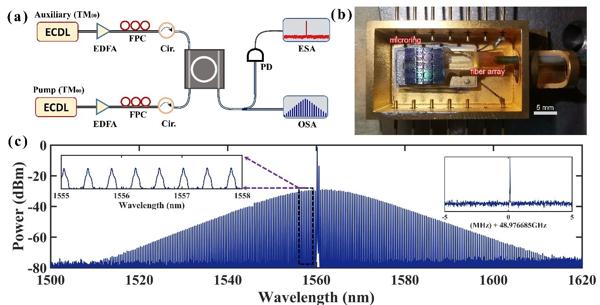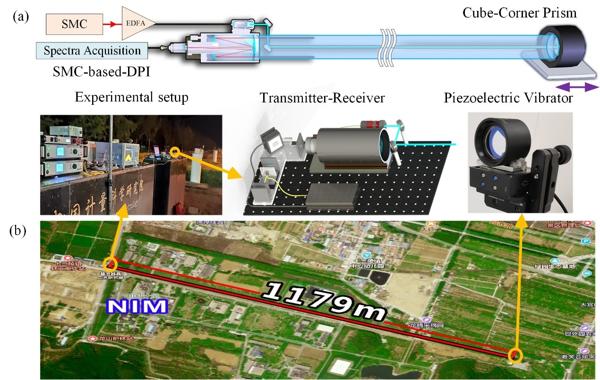High-accuracy long distance ranging plays a significant role in frontier sciences and advanced industrial processing, such as satellite formation flying, spacecraft landing, synthetic aperture radar (SAR), large-scale profile meter, which heavily relies on the precision of a real-time position detection system. During the past decades, laser-based light detection and ranging (LIDAR) takes a major interest in the scientific community for the high angle, distance and velocity resolution, high anti-interference capability.
Nowadays, with the rapid development of space exploration and industrial production, higher performance LIDARs are demanded. Recently, optical frequency combs (OFCs) are used as revolutionary laser sources to improve the ranging accuracy, acquisition speed and extend distances of LIDAR. However, it is still difficult to achieve high precision, high speed and large range simultaneously.
To solve this problem, a collaborative team lead by Prof. Fumin Zhang and Prof. Wenfu Zhang from Tianjin University and Xi'an Institute of Optics and Precision Mechanics developed a long-distance ranging over 1 km with high precision using the integrated broadband coherent soliton microcomb (SMC). The proposed ranging system eliminates the measuring dead zone induced by the mismatch between the repetition rate of traditional mode-locked laser based OFC and resolution of the optical spectrum analyzer. The results were published in Photonics Research, Vol. 8, No. 12, 2020(Jindong Wang, Zhizhou Lu, Weiqiang Wang, Fumin Zhang, Jiawei Chen, Yang Wang, Jihui Zheng, Sai T. Chu, Wei Zhao, Brent E. Little, Xinghua Qu, Wenfu Zhang. Long-distance ranging with high precision using a soliton microcomb [J]. Photonics Research, 2020, 8(12): 12001964).

Fig1. Soliton microcomb generation
In the work, a long-distance ranging system based on dispersive interferometry (DPI) was built where a series of technological innovation and engineering development were carried out:
1) A compact and ultrahigh repetition-rate SMC source (Fig.1) was employed for long-distance ranging. Every comb line can be distinguished using a commercial optical spectrum analyzer due to the ultrahigh repetition rate of SMC (about 49 GHz), and eliminate the dead-zone which perplexes the traditional mode-locked OFC based ranging system.
2) A high reliable micro-resonator packaging is adopted to improve the environmental adaptability of the SMC. The operation temperature of micro-resonator is controlled by using a TEC and a program-controlled single SMC generation system is employed.
3) To improve the measurement range, an auxiliary phase-modulated laser rangefinder (PLR) was employed to estimate the distance to be measured. Combined the estimated distance with the precious distance measured by the SMC-based-DPI, the non-dead-zone measurable distance is extended to 1500 m. Consequently, the application of long-distance measurement based on micro-resonator SMC is realized for the first time.

Fig.2 Long distance measurement based on SMC
The feasibility of the proposed ranging system is experimentally demonstrated in two scenarios. In the first scenario, an 80 m distance is measured in a well-maintained environment. The measurement results show that the proposed SMC LIDAR system has the potential to realize nanometric-precision measurement with high updating rate of 35 kHz. For the second scenario, the ranging system is built in an outdoor baseline for long distance measurement. At 1179 m, the high-frequency vibration with amplitude of tens of microns was successfully measured, and the minimum ALLAN deviation of the static measurement was 5.6 μm. Using a high-pass filter to sweep out the influence of air fluctuation, the minimum ALLAN deviation was reduced to 27 nm, which shows the excellent performance prospect of the proposed SMC LIDAR (Fig.2).
Pro. Fumin Zhang believes that SMC LIDAR could play a significant role in advanced manufacturing, industrial production, aerospace and other fields with great application potentials. Frequency stabilization and phase-locking, as well as instrumentation and integration are the development directions of SMC. In addition, for high-precision ranging systems, accurate calibration of air refractive index and elimination of the influence of air fluctuation are also urgent problems to be solved.


